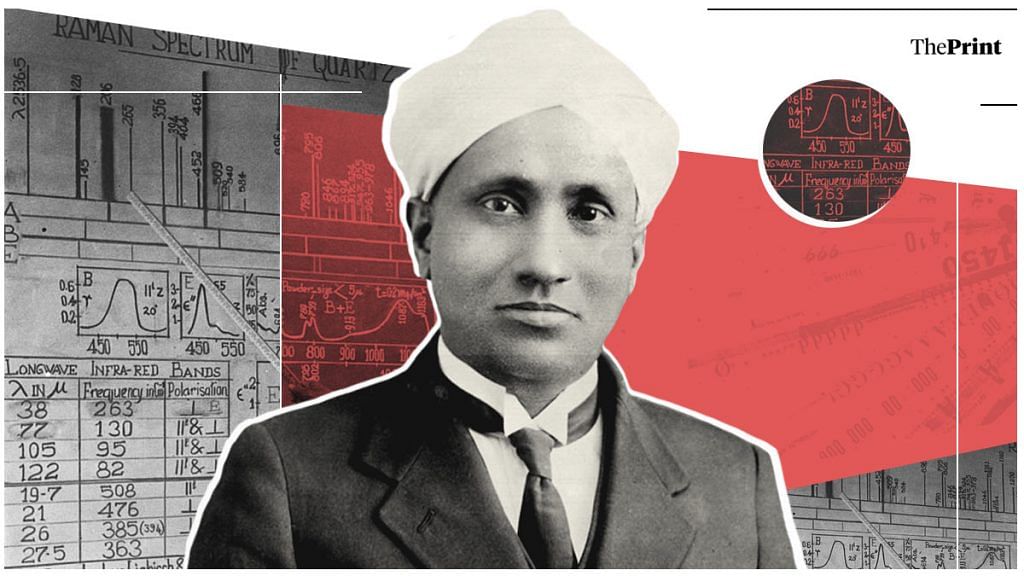Bengaluru: India celebrates National Science Day on 28 February every year in honour of physicist C.V. Raman’s discovery of the Raman Effect, which gave Asia its first Nobel in the Sciences in 1930.
Raman and his student-collaborator K.S. Krishnan made the discovery of the phenomenon in 1928. But Raman’s Nobel win came two years later. It was the first Nobel in Physics for a non-white person, and for an Indian scientist.
As India celebrates another year of the physicist’s discovery, ThePrint details the science behind it.
The Raman Effect
In 1921, C.V. Raman was on a trip to Europe when he noticed the striking blue colour of some icebergs and the Mediterranean Sea. He was inspired to want to understand the reason behind the phenomenon.
He conducted experiments with transparent blocks of ice and light from a mercury arc lamp. He recorded the spectra from shining the light through ice and detected what would come to be known as the Raman Lines, caused by the Raman Effect.
The Raman Effect is the process of scattering of light particles by molecules of a medium. The scattering occurs due to a change in the wavelength of light as it enters the medium. When a beam of light travels through a dust-free, transparent chemical, a small fraction of the light emerges in directions other than where it should.
Light consists of particles called photons, whose energy is directly proportional to the frequency with which they travel. When they strike molecules in a medium at high speeds, they bounce back and scatter in different directions depending on the angle with which they hit the molecules.
Most of these scatterings are elastic — the photons retain their energy and are deflected with the same speed as they were traveling with.
However, once in a while, the molecules of the medium light passes through absorb or give energy to photons that strike them. The light particles then bounce with decreased or increased energy, and thus, frequency.
When frequency shifts, so does wavelength.
This means that light refracted from a body, like the Mediterranean Sea or an iceberg, can appear to be of a different colour.
The effect is extremely negligible when measured and occurs in very low amounts, but each medium contains a specific molecular scattering signature, related to the particular molecule and its numbers.
This gave birth to the field of Raman spectroscopy, which has extensive applications around the globe, and across fields. It can help in determining chemical bonding structures, characterise materials, determine temperature, find out crystalline orientation, identify pharmaceutical chemicals, discover counterfeit drugs, identify pigments in old paintings and historical documents, and detect explosives using lasers from a distance.
Raman and Krishnan’s work was expected to win the Nobel Prize in Physics in 1928, and the next year, but didn’t until 1930. Raman won solely; Krishnan didn’t share the award, although his name was given an honourable mention.
Soviet physicists Grigory Landsberg and Leonid Mandelstam observed the effect in crystals just a week before Raman did, but Raman published his results first. The duo also ended up citing Raman in their study, and thus weren’t recognised as the original discoverers of the effect.
Also read: Scientists accidentally discover first animal that doesn’t need oxygen to survive
National Science Day
In 1986, the Indian government instituted the National Science Day on 28 February, to be celebrated annually in academic and scientific institutions of all levels. The celebrations include public speeches, TV programmes, science exhibitions, and science popularisation awards.
Every year, the day is celebrated with different themes to raise awareness about the importance of science in everyday life. The themes have ranged from waste management to information technology to GM crops. This year’s theme is ‘Women in Science’.
In an era of increased awareness about the problems plaguing women in STEM, many have criticised the commemoration of a well-celebrated male scientist, and setting the Nobel Prize, which is rapidly sinking into irreverence, as a benchmark.
Celebrating this year’s theme seems particularly ironic as Raman was well-documented for engaging in sexual discrimination against women in the sciences despite public championship of women’s education.
Raman denied admission to Kamala Bhagvat, a promising biochemist, to the Indian Institute of Science (IISc). She staged a satyagraha outside his office, after which he admitted her under the conditions that she will be on probation for a year and she shouldn’t be “a distraction” to male researchers.
(This report has been updated to reflect that C.V. Raman was the first non-white person to be awarded a Nobel in Physics)
Also read: Marsquakes and strange magnetic pulses — what NASA’s Mars mission has unveiled so far
